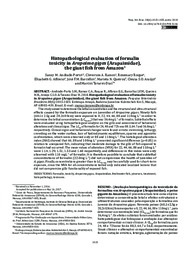Histopathological evaluation of formalin toxicity in Arapaima gigas (Arapaimidae), the giant fish from Amazon.
Histopathological evaluation of formalin toxicity in Arapaima gigas (Arapaimidae), the giant fish from Amazon.
Author(s): ANDRADE-PORTO, S. M.; RAMOS, C. A.; ROQUE, R.; AFFONSO, E. G.; BARCELLOS, J. F. M.; QUEIROZ, M. N.; ARAÚJO, C. S. O.; TAVARES-DIAS, M.
Summary: This study aimed to determine the lethal concentration and the structural and ultra-structural effects caused by the formalin exposure on juveniles of Arapaima gigas. Ninety fish (60.1± 2.5g and 20.2±0.9cm) were exposed to 0, 22, 44, 66, 88 and 110mg L-1 in order to determine the lethal concentration (LC50-96h) that was 36.4mg L-1 of formalin. Sublethal effects were evaluated using histopathological analysis on the gills and assessment of behavioral alterations and clinical signs. The LC50 of formalin for 24, 48 and 72h was 88.3, 64.7 and 56.8mg L-1 respectively. Clinical signs and behavioral changes were found: erratic swimming, lethargy, crowding on the water surface, loss of hydrodynamic equilibrium, spasms and agonistic confrontation, which were observed only at 88 and 110mg L-1. The histological alteration index (HAI) showed that 66, 88 and 100mg L-1 presented significant difference (p<0.05) in relation to unexposed fish, indicating that moderate damage to the gills of fish exposed to formalin had occurred. The mean values of alteration (MVA) for 22, 44, 66, 88 and 110mg L-1 were 1.14, 1.29, 1.51, 1.53 and 1.60 respectively, and differences in this index were only observed with 110 mgL-1 of formalin. It is therefore possible to conclude that sublethal concentrations of formalin (22.0mg L-1) did not compromise the health of juveniles of A. gigas. Finally, concentrations greater than to LC50-96h may be carefully used for short-term exposure, since the MVA for all concentrations tested only indicated localized lesions that did not compromise gills functionality of exposed fish.
Publication year: 2018
Types of publication: Journal article
Unit: Embrapa Amapá
Observation
Some of Embrapa's publications are published as ePub files. To read them, use or download one of the following free software options to your computer or mobile device. Android: Google Play Books; IOS: iBooks; Windows and Linux: Calibre.
Access other publications
Access the Agricultural Research Database (BDPA) to consult Embrapa's full library collection and records.
Visit Embrapa Bookstore to purchase books and other publications sold by Embrapa.

